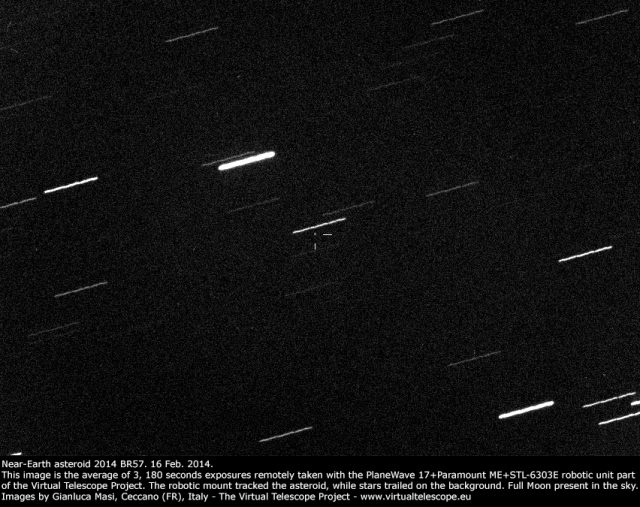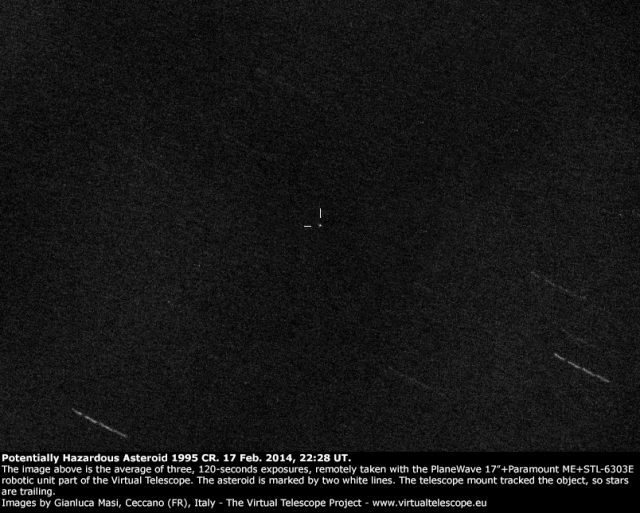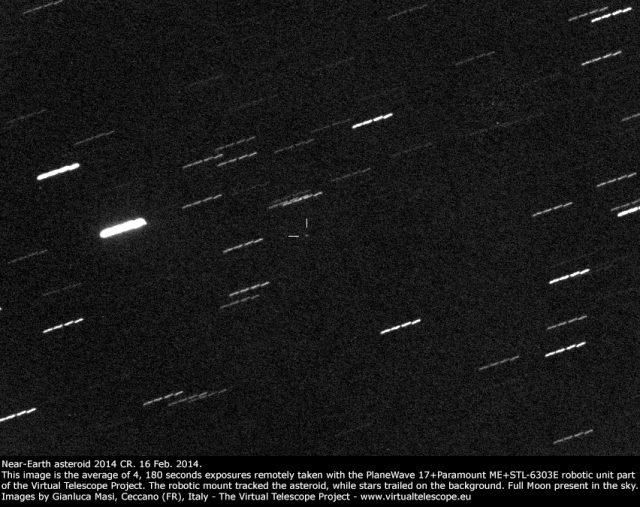A near-Earth asteroid relay race: 2000 EM26, 2014 BR57, 1995 CR and 2014 CR
*** See these near-Earth asteroids live with us! ***
Asteroids are truly fascinating objects. They are the leftover of the pristine material dominating the early Solar System, at times when the planets were just starting their formation.
Among that huge population (we know more than 600.000 objects, 50% of them have a well determined orbit), we recognize about 10.000 bodies approaching our planet within a given threshold (moving along orbits bringing them between 0.983 and 1.3 Astronomical Units from the Sun; an Astronomical Unit equals to the mean distance of the Earth from the Sun, about 149.6 millions of km): they are called near-Earth Asteroids (NEAs). Among them, we call potentially hazardous asteroids (PHAs) those on orbits approaching the one of the Earth within 7,500,000 of km and with a diameter larger than about 100 meters. To date, we know 868 NEAs with a diameter larger than 1 km and a total of 1457 PHAs (155 of them larger than 1 km).
As an obvious consequence of their orbits, NEAs can reach the proximity of Earth, sometimes posing a risk of collision and this is why we reserve a special attention to them. Handling these issues is a delicate matter, involving advanced mathematical and statistical considerations and we end with a impact probability and an impact risk for everyone of those objects. Of course, saying that an asteroid has a given probability to impact does not mean it will collide with us: probability is an expression of our uncertain knowledge of a given orbit and it evolves as the orbit itself becomes better and better determined.
At Virtual Telescope we always looked at NEAs and PHAs with interest, sharing live, online, the most spectacular of these close approaches and while we are writing, we have some NEAs around. Of course, we planned some live events to make possible for you to spot them!
Quite curiously, the Earth will be safely approached by four NEAs between 18 and 24 Feb., all coming within about 3 millions of km from our planet. It is worth to remind that our Moon is, on average, at about 384.000 km.
The first object opening this relay race is 2000 EM26: it is a potentially hazardous asteroid, with an estimated diameter of about 200 meters. Early on 18 Feb., this object reached a minimum distance from us of 8.8 lunar distances. 2000 EM26 was not observed since its discovery, so its position in the sky is largely uncertain and likely it will be missed, unless wide field surveys will try for it. For these reasons, Virtual Telescope did not organize an event for it. As far as we know, it went unobserved around the nominal close encounter.
Next, near-Earth asteroid 2014 BR57 will come into play. On 20 Feb. 2014 at 16:58 UT this 70 meters object will brush our Earth at 4.4 lunar distances. We will share it live next 19 Feb. at 20.00 UT and below is an image we already grabbed a couple of nights ago:
Then, we welcome 1995 CR, a potentially hazardous asteroid with an estimated diameter of 210 meters that will be, on 21 Feb. 2014 at 11:08 UT, at 7.6 lunar distances. Of course, we will cover it on 20 Feb. 2014, starting at 20:00 UT. We already captured it and here is a preview, waiting for the live coverage:
Finally, the near-Earth asteroid 2014 CR, with an estimate diameter of 130 meters, will close the curtain on 24 Feb. at 00:21 UT, at 8.3 lunar distances. We will observe it with 1995 CR, during the same live session. In the meantime, here it is 2014 CR, as from a couple of nights ago:
Once again, the Virtual Telescope will be the only robotic facility in the world sharing all this great stuff with people from all around the globe and we hope you will award our dedication contributing to our activities by donations.
Support The Virtual Telescope Project!
Support us! Please, donate and receive an EXCLUSIVE image of the stunning COMET C/2023 A3 Tsuchinshan-ATLAS and much more, specifically made for supporters like you!
![]()













